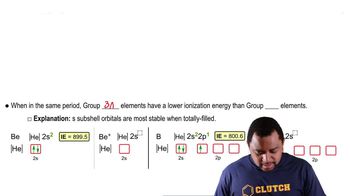Here are the essential concepts you must grasp in order to answer the question correctly.
Oxidation State
The oxidation state, or oxidation number, is a theoretical charge assigned to an atom in a compound based on the assumption that electrons are completely transferred. It helps in understanding the electron distribution in molecules and is crucial for determining how elements react chemically. Oxidation states can be positive, negative, or zero, and they follow specific rules for calculation.
Recommended video:
Group 3A Elements
Group 3A elements, also known as Group 13 elements, include boron (B), aluminum (Al), gallium (Ga), indium (In), and thallium (Tl). These elements typically exhibit a +3 oxidation state in their compounds, although they can also show other oxidation states depending on the chemical environment. Understanding the common oxidation states of these elements is essential for predicting their behavior in chemical reactions.
Recommended video:
Group 3A vs. Group 2A Elements
Ionic and Covalent Compounds
Compounds can be classified as ionic or covalent based on the nature of the bond between their constituent atoms. Ionic compounds, formed between metals and nonmetals, involve the transfer of electrons, leading to the formation of charged ions. In contrast, covalent compounds involve the sharing of electrons between atoms. Recognizing the type of compound helps in determining the oxidation states of the elements involved.
Recommended video:
 Verified step by step guidance
Verified step by step guidance

